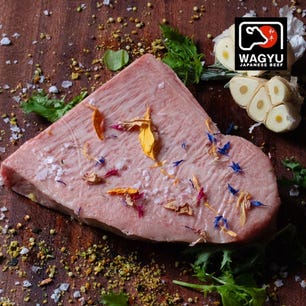Wagyu, the absolute excellence of Japanese meat
While in the Land of the Rising Sun the term Wagyu is used simply to refer to the "Japanese beef," throughout the rest of the globe this word is instead synonymous with a highly prized and legendary dish, the ultimate in beef. One of the most prized and sought-after meat in the world. Indeed, wagyu is an iconic meat, characterized by a unique marbling that gives it excellent qualities.
There is a real grading system for kobe beef, drawn up by the Japan Meat Grading Association according to strict parameters. Basically, this ranking shows the yield grade (A, B or C) and meat quality grade (1-5) of each individual animal.
These two indicators combined together define the beef ranking: the A5 Wagyu is the score that is used to indicate the best possible quality. Then there is an additional index -the BMS: Beff Marbling Standard - certifying the percentage of marbled fat per animal, which is then calculated from 1 (low) to 12 (maximum).
The history of Japanese Wagyu beef
From its origins in the countryside of Kobe Prefecture where they live in a stress free environment, to the cuisine of the most renowned starred restaurants on five continents. That wagyu is considered the "Rolls-Royce" of beef is a matter of common knowledge. Wagyu meat began appearing on Japanese tables relatively recently.
In fact, until the 1870s, the Japanese Empire prohibited the consumption of four-legged animals based on religious restrictions and social customs widely spread throughout the prefectures. Cows, for example, were used only as draught animals.
However, during the 19th century, under increasing pressure from the great colonial powers, Japan was forced to embark on a new political course of opening up to the West and its trade. In those years, therefore, various European breeds and American Angus began to land on Japanese soil, which were soon crossed with native cattle. From there to considering abstention from beef consumption unreasonable was a very short step.
Toward the end of World War II, in 1944 to be exact, as many as four breeds of wagyu cows were then identified: the black (Kuroge Washu), which accounts for 90 percent of today's domestic wagyu breeds; the brown (Akage Washu) also known as the "red" which accounts for the second largest breed raised; the hornless (Mukaku Washu); and the Shorthorn (Nihon Tankaku Washu), which is only 1 percent of the breeds currently raised.
To date, there are nearly 200 strains of wagyu cattle native to Japan, each with its own characteristics that differ from territory to territory and depending on the techniques and feeds with which they are raised. Among these strains, the most famous is the wagyu from Kobe Prefecture.
The reasons for such fame lie in the standards of excellence that each animal must achieve. Meanwhile, they are all specimens raised within the prefecture and weigh no less than five quintals. Their BMS (the percentage of marbling) cannot be less than 6 and the quality and yield grade of their meat must be at least a 4B. Very strict parameters -which only an average of 3,000 head each year can guarantee.






